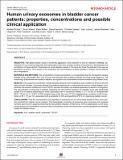Files in this item
Human urinary exosomes in bladder cancer patients : properties, concentrations and possible clinical application
Item metadata
| dc.contributor.author | Riches, Andrew Clive | |
| dc.contributor.author | Powis, Simon John | |
| dc.contributor.author | Mullen, Peter | |
| dc.contributor.author | Harrison, David James | |
| dc.contributor.author | Hacker, Christian | |
| dc.contributor.author | Lucocq, John Milton | |
| dc.contributor.author | Bowness, James Simeon | |
| dc.contributor.author | Chapman, Alex | |
| dc.contributor.author | Cameron, Ruth | |
| dc.contributor.author | McLornan, Liz | |
| dc.contributor.author | Chinn, David John | |
| dc.contributor.author | Leung, Steve | |
| dc.date.accessioned | 2016-01-13T15:40:10Z | |
| dc.date.available | 2016-01-13T15:40:10Z | |
| dc.date.issued | 2015-12-11 | |
| dc.identifier | 240104405 | |
| dc.identifier | 8dc91e51-cb07-4016-9558-668a94199d75 | |
| dc.identifier.citation | Riches , A C , Powis , S J , Mullen , P , Harrison , D J , Hacker , C , Lucocq , J M , Bowness , J S , Chapman , A , Cameron , R , McLornan , L , Chinn , D J & Leung , S 2015 , ' Human urinary exosomes in bladder cancer patients : properties, concentrations and possible clinical application ' , Bladder , vol. 2 , no. 3 , e19 . https://doi.org/10.14440/bladder.0.63 | en |
| dc.identifier.issn | 2327-2120 | |
| dc.identifier.other | ORCID: /0000-0003-4218-2984/work/60195331 | |
| dc.identifier.other | ORCID: /0000-0001-9041-9988/work/64034358 | |
| dc.identifier.other | ORCID: /0000-0002-5191-0093/work/64361269 | |
| dc.identifier.other | ORCID: /0000-0002-8665-1984/work/101958708 | |
| dc.identifier.other | ORCID: /0000-0002-0841-609X/work/157141058 | |
| dc.identifier.uri | https://hdl.handle.net/10023/8016 | |
| dc.description.abstract | OBJECTIVE: High grade bladder cancer is extremely aggressive. Early detection is thus an important challenge. De- velopment of non-invasive diagnostic tools particularly using urine samples could be of importance in the diagnosis and surveillance of these patients. Exosomes are small vesicles present in the urine and have the potential to be used as biomarkers of cancer. Thus studies of the properties and concentrations of these particles in bladder cancer patients are of importance.MATERIALS AND METHODS: The concentration of exosomes present in urine was determined by nanoparticle tracking analysis using a Nanosight LM10 unit. Clinical urine samples were routinely collected and fixed using Preservcyt. The morphology of exosomes was studied in electron micrographs and characteristic exosome markers using Western blots.RESULTS: The exosome concentration of fixed samples stored at room temperature was constant for 48 hours and the same as fresh samples. Exosomes derived from patients presenting for a transurethral resection of their bladder tumor exhibited the exosome markers ALIX and TSG101 and also the classic cup shaped appearance in electron micrographs. The concentration of exosomes in patients presenting for transurethral resection of a bladder tumor was significantly greater than in patients presenting for check cystoscopy with no recurrence (median 77.2 × 108 per ml compared with 38.8 × 108 per ml, P < 0.001). A ROC analysis (area under the curve 77.4%) suggested that a suitable cut-off concen- tration of 85 × 108 per ml is associated with a sensitivity of 43% and specificity of 91% for diagnosing bladder cancer.CONCLUSIONS: Thus the concentration and properties of exosomes can be conveniently studied in fixed urine sam- ples derived from bladder cancer patients. The characteristic properties of exosomes were preserved and increased numbers were found in patients presenting for transurethral resection of their tumor. With an appropriate cut-off value, urinary exosome concentrations may have utility in excluding a cancer recurrence when monitoring patients successfully treated for bladder cancer. | |
| dc.format.extent | 7 | |
| dc.format.extent | 4092896 | |
| dc.language.iso | eng | |
| dc.relation.ispartof | Bladder | en |
| dc.subject | ALIX | en |
| dc.subject | Bladder cancer | en |
| dc.subject | Exosomes | en |
| dc.subject | TSG101 | en |
| dc.subject | RB Pathology | en |
| dc.subject | RC0254 Neoplasms. Tumors. Oncology (including Cancer) | en |
| dc.subject | NDAS | en |
| dc.subject | SDG 3 - Good Health and Well-being | en |
| dc.subject.lcc | RB | en |
| dc.subject.lcc | RC0254 | en |
| dc.title | Human urinary exosomes in bladder cancer patients : properties, concentrations and possible clinical application | en |
| dc.type | Journal article | en |
| dc.contributor.institution | University of St Andrews. School of Medicine | en |
| dc.contributor.institution | University of St Andrews. Biomedical Sciences Research Complex | en |
| dc.identifier.doi | 10.14440/bladder.0.63 | |
| dc.description.status | Peer reviewed | en |
This item appears in the following Collection(s)
Items in the St Andrews Research Repository are protected by copyright, with all rights reserved, unless otherwise indicated.

